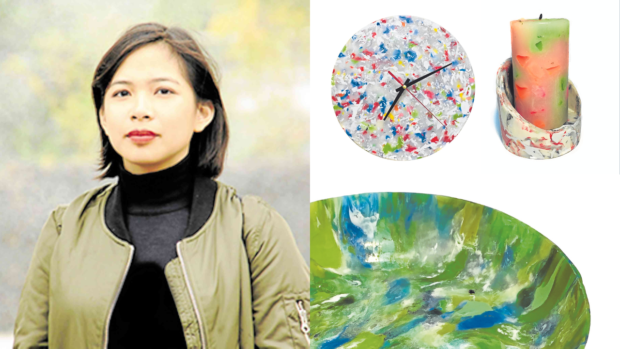
From a distance, the deep bowls look like blown glass with a marbleized design. Streaks of blue and green with a splash of red or violet catch the eye. The limited range includes planters and pillar candleholder, clocks and coasters but none of them are made of glass or fashioned out of marble.
They’re all made of plastic waste cleaned and collected by poor communities in Quezon City, and recycled into home items by Plastics by Manila Automat.
Industrial designer Mica Agregado has been experimenting and developing with plastics since 2016 and initially began selling what she made at weekend bazaars.
“My family’s business involves hosting a lot of events where we end up with a surplus of bottle caps. I wanted to make something out of these and other recyclable plastic wastes,” Agregado told Lifestyle.
From the seven types of commercial plastics, she and the team behind Plastics by Manila Automat focused on using three of the most common ones that can be melted and reshaped. Local crafters and creators have made “ecobricks” out of PET bottles and accessories and furniture out of plastic foil sachets. Plastics by Manila Automat believes that upcycling can influence people’s perspective of the plastic problem by innovating the way they use single-use plastics.
Involving communities
To do this, the company involves Quezon City communities—and soon from Parañaque as well—in the collecting, sorting and cleaning of components like discarded plastic bottle caps, shampoo bottles and lids, bread tabs and takeout containers.
“Tying up Loose Ends” is the group’s public advocacy initiative where the studio engages with communities in the form of collection drives, online video programs, on-ground demonstrations and craft workshops to encourage them to be potential recyclers.
Agregado explained that the commercial plastics we use daily—from bottle caps to food containers—all derive from plastic pellets. Through the 3Cs (collect, clean and create), they are able to make a new cycle by reverting clean single-use plastics according to type and repurposing them by making all sorts of multicolored objects through remelting and molding. Aside from the products mentioned, they’re expanding the range to include mirror frames and lighting fixtures.
“We’re very particular with colors to the point that we’ve identified different shades of green and make sure that they’re sorted accordingly,” she said.
Aside from involving communities so they become aware of the concept of “precious plastics,” they also hold workshops for students and are open to collaborate with designers, crafters or businesses. One of their more recent collaborations was with e-commerce site Itooh for an exclusive collection of stools made from recycled plastic.
“When plastics were first introduced in 1907 by Leo Baekeland, they were seen as a solution to people’s needs. I want to return to that point when plastics were a positive,” Agregado said. INQFollow Plastics by Manila Automat on Facebook; @plastics.manila.automat on Instagram.

